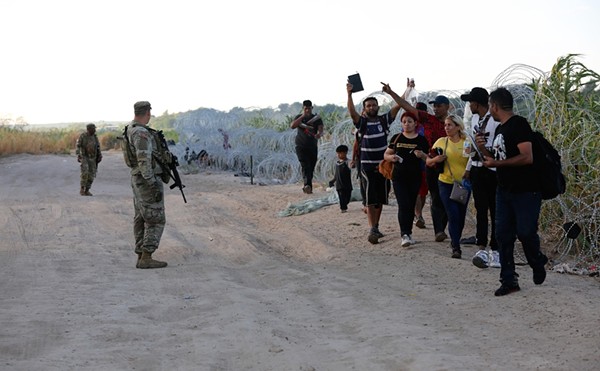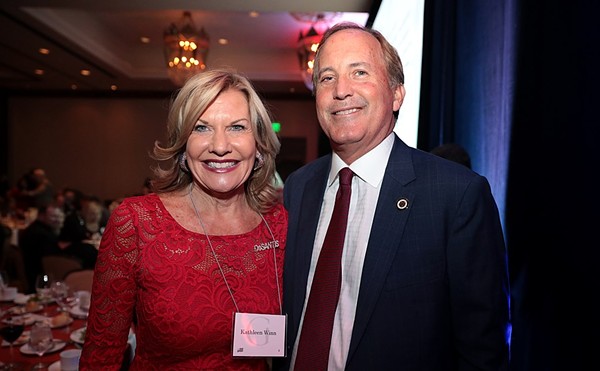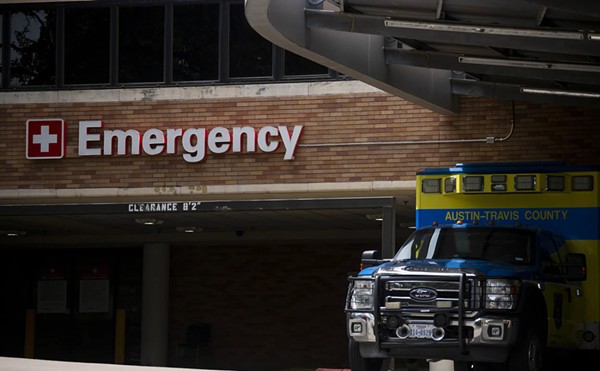In 2006, the City Council took on Mayor Phil Hardberger's challenge to become the country's largest "no-kill" community. At the time, ACS was gassing 50,000 animals a year and the population of stray dogs and cats was burgeoning. The live release rate — the percentage of animals picked up by San Antonio Animal Control Services and returned to their homes or adopted out — was in the single digits. To become no kill, the City pledged to raise the live-release rate from a dismal less-than-10 percent to 70 percent by the beginning of 2012. It was an ambitious goal that hasn't proven kind to all animals alike.
A new ACS headquarters replaced the 60-year-old dog pound in Brackenridge Park. Lethal injection replaced the gas chambers. To reflect changing priorities, the agency changed its name from Animal Control to Animal Care Services, shifting its core mandate from simply removing strays from the streets to promoting adoption and spay-and-neuter policies.
A coalition of civic organizations coalesced around the no-kill goal. The Humane Society and the Animal Defense League climbed on board, and the San Antonio Area Foundation provided significant financial support. The five-year deadline came and went. And though we remain a far cry from attaining no-kill, there has been progress.
Leadership at ACS also changed. In September 2011, former director Gary Hendel was demoted. Assistant City Manager Erik Walsh cited the changing nature of ACS in a letter to Hendel. "Areas of deficiencies have been discussed with you in the past," Walsh wrote. "I believe these deficiencies have and will prevent the Department from moving to the next level." Joe Angelo, a consultant from the City's Office of Innovation and Reform, was tapped to head the agency as interim director that same month. Meanwhile, the City drafted a new plan for reaching no-kill status. Angelo, replete with a degree from Harvard's Kennedy School, was tasked with implementing that plan. "I think that we have begun to see a shift," said the ever-optimistic Angelo. "A shift that every single successful no-kill city has seen when they transition from being a high-kill shelter to a no-kill shelter." Under his tenure, live-release rates rose rapidly: from 31-percent in 2011 to 58-percent by the second quarter of 2012. Gavin Nichols, who oversees the Animal No Kill Initiative at the San Antonio Area Foundation, termed the leap "excellent" while calling the ultimate no-kill shortcoming "old news." But some animal rights advocates warn that the rapid progress has come at a cost.
We're assembling a photo project dedicated to San Antonio's stray cats and dogs. Send your stray pics to [email protected].
The video shows a two-inch strand of mucus hanging from the nose of a painfully thin kitten whose eyes are matted shut. Exposed to their ill sibling's disease, healthy cats frolic nearby in the same cage. In another video, used needles are crammed into an empty water bottle at a veterinarian's ad hoc workstation. Clean gloves sit in a contaminated tray. Elsewhere, a handwritten sign reading "medicine" is taped to a folding table covered in veterinary supplies. Clean syringes and medications sit next to dirty feeding spoons. Used needles are shoved into an empty sanitary wipes container.
These scenes from the San Antonio Pets Alive! Kitten Ward in late May, 2012, depict an animal rescue organization overwhelmed by the more than 100 cats in their care, according to the volunteer who recorded the videos.
All of these kittens were pulled from ACS. Funded by a $300,000 grant awarded last February by Ogden, Utah-based animal welfare nonprofit Best Friends Animal Society and PetSmart Charities, the agency pays SAPA $50 for each animal it receives. By acting as the shelter of last resort — taking in cats and dogs on the City shelter's euthanasia list —SAPA is part of San Antonio's broader campaign to treat its animal population more humanely.
In a July 24 complaint filed with the City, Elizabeth Overcash, a researcher at People for the Ethical Treatment of Animals, alleged that the mortality rate of kittens at SAPA was "extremely high." Amid a raft of other concerns over the facility, Overcash also cited instances of underfed kittens dying slowly from a lack of veterinary care.
Shari Pearson, an animal rights activist and PETA member, recorded these and other instances of what she characterized as neglect while volunteering with SAPA "You have to have proper care," Pearson said. "They aren't providing it." The videos made by Pearson aired as part of a story July 25 on San Antonio TV station KSAT 12.
Holly Livermore, operations manager for SAPA, dismisses the notion that they might be overwhelmed. She helped launch the group in January as a spin-off of Austin Pets Alive! "I feel that we are having growing pains that any other new group would have," Livermore said. "But we can't just give up." That many of the animals they receive from ACS are ill or injured — and that some will die — is not contested by SAPA. In a prepared statement forwarded to the Current, SAPA director Dr. Ellen Jefferson relates, "The story [on KSAT 12] focuses on the very young kittens that we have saved from certain death. Because they are often sick when we save them, there is a certain percent that do not survive but it is not for a lack of trying. Even in nature with a mother, only 80 percent of kittens survive. Kittens with no mother, sickly, and probably neglected before even making it into the shelter, have an even lower survival rate." And Lynn Walker, SAPA marketing officer, questions the obligations the ex-SAPA volunteer had to the immediate welfare of the animals in apparent distress while documenting their condition. "That video was taken in the middle of the night. They didn't follow any of our protocols on what you are supposed to do if you find a sick animal. They didn't ask for any help. They didn't notify anyone," she said.
The May video of sick young kittens presents an undeniably disturbing scene. But a report made available to the Current of a recent unannounced visit by ACS inspectors to the Kitten Ward on July 19 paints a different picture, certifying that, "The cats in the facility were clean, healthy, and alert. ... The staff was knowledgeable and well informed about the cats and kittens in their care." Signed by Aimee DeContreras, Animal Care Service field operations supervisor, the report concludes, "We left the SAPA location and did not see any concerns at this time." Emphasizing SAPA's history of positive reviews by ASC, Walker (herself a SAPA volunteer currently fostering four dogs) relates that over 4,000 cats and dogs have been saved in the past six months through their Warbach Road Kitten Ward and the intake and dog facility at ACS Building #1. Many have been abuse cases. "A lot of false information gets out there," Walker told the Current. "It's frustrating, but instead of staying on the negative, we try to keep pushing forward. So we just tell people, come down and see for yourself."
Livermore attributed some of the allegations against SAPA to the internal politics of the animal-rescue community. "There's always going to be some head-butting," she said. "Everything gets sensationalized." PETA as an organization has generally opposed no-kill solutions, contending that they too frequently leave animals warehoused in unsanitary conditions while new homes are sought for them. Best Friends' PR senior manager John Solis bemoaned the criticism of SAPA, writing in a July 28 letter to Mayor Julián Castro,"It's ironic that PETA, an organization that routinely attempts to derail credible life-saving programs simply because it does not support the no-kill movement, has once again tried to discredit a promising program that has since its inception had broad support from the San Antonio animal welfare community."
Other American cities that have already reached no-kill status have found maintaining that progress to be the biggest challenge of all. Austin boasts live release rates around 90 percent. The state capital reached no-kill status in 2011 and is often cited as an example for San Antonio to follow. "People say Austin is different — it's more affluent, they're better educated, blah, blah, blah. Personally, I don't buy it," the Area Foundation's Nichols said. "They just had the formula and the will to make it happen."
San Antonio has departed from some other models with Angelo's emphasis on public-private partnerships. "I wouldn't take a contract in a million years," said Paula Fasseas, founder and chair of PAWS Chicago. A private, no-kill shelter, PAWS Chicago has been instrumental in reducing the number of animals euthanized in America's third-largest city while making spay-and-neuter more accessible. "I am not the dogcatcher," Fasseas said. "Don't take it in … if you don't have the resources to save it. Let it go to the City pound and other rescue groups, other shelters. Private groups should take on animals as they develop the capacity to care for them humanely."
In Austin, there is similar skepticism about relying too heavily on private groups.
"That's not the model," said Abigail Smith, chief animal services officer for the city of Austin. "The rescue groups are private not-for-profits and it's their mission to save animals. We help them where we can," Smith said.
Despite their progress, the longevity of Austin's no-kill initiative is being tested. "Austin is struggling right now," Nichols said. "Reaching no-kill is easier than maintaining no-kill."
Smith admits each year is different. "Earlier this year, we did a great job of keeping our intake numbers down, but it fluctuates. You look at 10 or 12 years of data and it's up and down."
While Austin seemed to rapidly surpass its no-kill goals, Smith emphasizes it's a long-term process. "If you're just doing animal control rather than prevention, it's impossible," said Smith. "No municipal shelter can be big enough to do it alone. But it's not just private groups, it's community members as well."
What's missing from the drive to no-kill, critics argue, is an aggressive spay-and-neuter program.
"You can't adopt your way to no kill," John Bachman said of San Antonio's emphasis on adoption. A retired nuclear engineer turned gadfly, Bachman is a member of local animal rights group Voice for Animals who supports a mandatory spay-and-neuter policy. A June 2010 story by Callie Enlow in the Current stated that of a SA focus group survey done at the time, "the majority favored mandatory spay-and-neuter for all city pets, with the exception of service dogs, show dogs, and police and military dogs." Similar goals for a near-universal spay-and-neuter mandate in Chicago have been applauded by PAWS director Fasseas. And though there is some popular support for such measures, fears of government intrusion combined with the influence of vested interests — such as breeders' associations and private veterinarians — have thwarted proposals when they have appeared.
The Area Foundation projects that 100,000 spay or neuter surgeries will have to be performed each year for three to five years in order to level off San Antonio's unwanted dog and cat population. ACS's current goal for 2012 is 65,500 sterilizations. As of June, they were 81 percent of the way there, according to the Area Foundation. Bachman, however, believes the needed annual neuters are closer to 150,000. "And defining no-kill at 70-percent?" says Bachman. "The no-kill community at large has said if you could put a percentage on it, it is more around 90-percent."
In setting such a low threshold for no-kill status and racing so urgently to reach it through adoption efforts, critics such as Bachman and Walls worry ACS is more concerned with creating a quick turnaround — a political success story — than a no-kill community. But, countered Angelo, "Is it fair for us to move that bar so far when we have other challenges as well? If we want to venture off into that 80-percent, 90-percent, 95-percent, clearly it's going to require a committed and sustained level of support."
Buying into PETA's claims that SAPA is a failed organization, Bachman said, "Right now, they're doing too much, too fast, with too little — both ACS and the private groups."
But groups like the highly regarded ADL shirk off critics' claims as misdirection. "The private groups are saving the lives of the very large number of unwanted animals that ACS takes in but was not able to find homes for," said Janice Darling, ADL's executive director. "If there are issues that need to be clarified, the City is open to finding a resolution and working to find a solution."
"Any time there is an animal problem, the tendency is to look to government — the government will take care of it," ACS spokeswoman Lisa Norwood told the Current. "But the problem is of such a magnitude that you have to look to community engagement if you expect a lasting solution. The community has to become engaged in becoming proactive, in embracing responsible pet ownership, and spay-neuter above all. It's not a problem if animals are not being born. "
One of the most robust sites of public engagement is on the streets, where volunteers look after feral, or free-roaming, cats. Though once an act of civil disobedience, "Trap-Neuter-Return has been legal in San Antonio for several years now," said Norwood, "The City decided to make TNR legal by design. It's the best way to address a feral cat population — and we have a lot of feral cats in San Antonio. The best way to accomplish it is by trapping those animals humanely, getting them sterilized and vaccinated, then returning them to their colony, where they can be cared for by a colony manager." The crazy cat lady (and cat dude) have finally been decriminalized.
"One of the initiatives we began in the last year is a partnership with Best Friends Animal Society," Norwood said. "They have been excellent partners, not only in implementing TNR, but in increasing people's awareness." Funded by a $700,000 grant from PetSmart Charities administered by Best Friends Animal Society, the Community Cat Program will enable 10,500 cats within 14 zip codes in SA to be spayed or neutered over a three-year period. And though TNR saves feral cats from euthanasia, the project — like similar TNR programs in towns and cities across the country, and abroad —addresses cat over-population by accepting, rather than fighting against an historical certainty. Humans and cats have co-evolved; where there are cities, there are cats. According to TNR advocates, simply removing feral cats from urban areas doesn't work. Cats are territorial; as soon as unclaimed territory becomes available, cats competing for space in nearby colonies move in, and if un-neutered, begin breeding.
In San Antonio, Best Friends provides a full-time employee to oversee the program, and works with ACS who assist with sterilization, vetting, and the trapping process. But the main corps of volunteers belong to the several animal rescue nonprofits that form the San Antonio Feral Cat Coalition, who have trained over 3,500 volunteers in TNR. Several SAFCC members, such as the ADL and SA Humane Society, provide discounted sterilization and vaccination services. SnapUS maintains a mobile clinic that serves several neighborhoods, while SpaySA provides free spay/neuter and vaccination services to cats in the 14 zip codes within the Community Cat Program.
Local TNR programs have also received support from the SA Area Foundation. But even with the Best Friends now in place, is enough being done? "In the first half of calendar year 2012, the high-volume clinics reported 3,284 feral cat surgeries. That same time period in 2011, 2,336 —almost 1,000 more," said Nichols of the Area Foundation. "In 2011, 20 percent of all cat neuter surgeries were feral. This year feral cat surgeries made up 32 percent." Improvements are being made. Nichol's organization has a goal of neutering 6,000 feral cats a year, and is committed to TNR. "People are moving from feral cat to community cat in their speech because not all cat colonies are entirely feral. Many are owned cats that people allow to roam freely," said Nichols. "We firmly believe TNR is integral to the no-kill program, and that TNR is the only effective means of controlling and ultimately reducing the population of free-roaming cats. It's proven, and is the only thing that actually works."
Another leadership change is in the works at ACS. On August 20, Kathy Davis took charge of the agency. In a sharp contrast to Angelo's business background, Davis has worked on animal care issues for more than a decade, giving some in the animal rescue community high hopes for her success.
Davis was director of code compliance in Dallas from 2002 to 2008. She comes to San Antonio from Los Angeles where she headed the Jason Debus Heigl Foundation, a philanthropy devoted to combating animal cruelty. Though new to the job, Davis is optimistic and complimentary to previous leadership. "Amazing strides have been made this past year towards achieving the goal," Davis said in an email to the Current.
Among those strides has been Angelo's development of public-private partnerships like the ones forged with SAPA and Best Friends Animal Society. "My initial plan will be to continue to build on the positive, progressive partnerships that are successfully in place," Davis said. Davis has her eye on the long-term, however. Spay-and-neuter programs as well as education projects are among her top priorities. "Once we attain no-kill, we cannot pull the plug on the programs most responsible for getting us there," Davis said.
Though impressed with Davis' experience, Pearson and others have grown accustomed to disappointment. "As soon as the pressure's off, it goes to crap again," Pearson said. "We need a director who has empathy." Could Davis be the one?

















